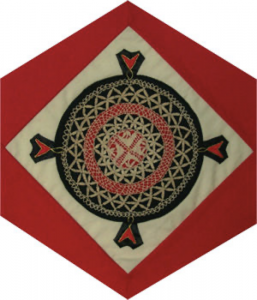Malta

The Block
A piece of Maltese bobbin lace, representative of a craft dating back to the sixteenth century, forms the centrepiece of the Malta block. This family heirloom, which is set against a coloured background to visually enhance the intricate design, was donated by the block-makers, Madlene and Richard Cumbo. It is characteristic of the Maltese lace technique that was influenced by Genoa, but which has developed its own unique style. The majority of Maltese lace is made from honey-coloured silk; however this example is worked in linen threads, which are typically used to create pieces for household purposes. The 8-pointed Maltese Cross, woven into the centre, is a distinguishing feature of this form of lacework. Made from four straight-lined, arrowheads that meet at their points, with the ends of the arms consisting of indented Vs, the cross is a symbol of protection and a badge of courage and honour. It was first given to the Knights of St. John who, during the defence of the Holy Land, risked their lives in an effort to save their kinsmen from a painful, fiery death. It has since become the international symbol of firefighters and their willingness to make sacrifices to protect others. Individual parts of the Maltese Cross, stitched outside the lace design, complete the piece
Cultural Profile
Malta, a small republic south of Sicily in the middle of the Mediterranean, is comprised of three islands: Malta, Gozo and Comino. It is known as the ‘bridge between the Arab world and Europe’. It possesses a legacy of architecture, including megalithic temples dating back to 3800 B.C., and treasures from the Roman and Byzantine empires. In 1530, the islands were given to the Knights of the Order of St. John of Jerusalem who helped defend them against invaders. Malta is one of the few places in the world to be awarded the George Cross (Britain’s highest award for civilian bravery), which it received in 1942 to honour the heroism of its people during World War II. The official languages of the island are Maltese, derived from a now extinct Sicilian-Arabic language, and English, which 88% of the population can understand. Malta’s culture reflects the influences of different countries, in particular Italy and the United Kingdom. The island is known for its fine crafts, which include handmade lace, handwoven fabrics, Medina blown glass, woven silk carpets, and silver filigree. Folk traditions in music and storytelling are strong. Imnarja, the principal folk festival, is highlighted by Ghana (folk singing over guitar), and the annual Carnival includes vigorous dances such as the Parata (sword dance) and Il-Maltija (national dance), but also parades and costumes. Ħrejjef, or legends, also play a big part in the country’s culture and they are common reading material for children. Another tradition that still endures is the village celebration of its patron saint’s day, which includes solemn procession of the saint’s statue, bands, fireworks and parades. Folk costumes are now worn only for special occasions, and the traditional Faldetta (a large hood-like headdress, stiffened with whalebone) is rarely seen. The first documented Maltese to arrive in Canada was Louis Shickluna, who in 1838 established a large and prominent shipyard on the Welland Canal, between Lake Erie and Lake Ontario. It was not until post-World War II that the majority of Maltese immigrants arrived here. Overpopulation, unemployment and the limited resources available to support a growing population were key factors in the Maltese emigration. Initial newcomers settled in Ontario, and it was not long before immigrant enterprises including bakeries, real estate firms and travel agencies began to emerge. In addition, organizations such as the Maltese Protective Society, Maltese-Canadian Society of Toronto, the Grand Priory of Canada of the Sovereign Order of St. John of Jerusalem (Knights of Malta) and the Maltese Veterans Association were established. Today there are over 50,000 people of Maltese origin in Canada. The largest Maltese community is in Toronto, with smaller groups located throughout Ontario, Montreal, Winnipeg and Vancouver. Maltese have made, and continue to make, major contributions to Canadian life in a number of fields, including law, medicine, banking, public service, and print and broadcast media.
Sponsor: Alan and Audrey Bain, in memoriam Anne and James Bain
